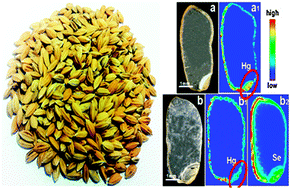Selenium modulates mercury uptake and distribution in rice (Oryza sativa L.), in correlation with mercury species and exposure level†
Abstract
Rice cultured in Hg- and/or Se-contaminated fields is an important food source of human Hg/Se intake. There are elevated Hg and Se levels in the soil of the Wanshan District, Guizhou Province. Here we attempted to explore how a Hg antagonist, Se, modulates the absorption and accumulation of inorganic mercury (IHg) and methylmercury (MeHg) in rice. The effects of Se on the content and transportation of Hg in hydroponic and soil cultured rice plants were examined. The results show that IHg mainly accumulated in the rice roots, but some also accumulated in the rice grain. In comparison to IHg, MeHg can be concentrated in the rice grain, and the proportion of MeHg in the rice grain may account for above 40% of the total Hg. Se can protect against Hg phytotoxicity in rice and inhibit IHg accumulation in rice tissues, but was not remarkable for MeHg at a low dosage exposure level in this study. These discrepancies imply mechanistic differences between IHg and MeHg absorption and accumulation in rice. This study illustrates that Se plays an important role in modulating Hg uptake, transportation and accumulation in rice. Therefore, Se is considered to be a naturally existing element that effectively reduces Hg accumulation in rice, which may have significant implications for food safety.


 Please wait while we load your content...
Please wait while we load your content...